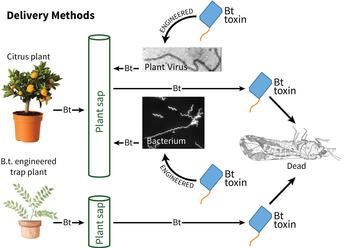A new, Bt toxin-based strategy for suppression of the Asian citrus psyllid vector of HLB

Article written by Bryony Bonning, Elizabeth Grafton-Cardwell, Peggy G. Lemaux, & Lukasz Stelinski.
Revised July 24, 2017.
What is the technique?
When the Asian citrus psyllid feeds, it can inoculate the host plant with the CLas bacterium that causes HLB or citrus greening, causing severe damage to the plant. A multi-pronged approach is required for management of this complex citrus disease. One approach to suppress the numbers of psyllid vectors is to use naturally occurring insecticidal toxins that are produced by a soil-borne bacterium, Bacillus thuringiensis (Bt). These toxins are harmless to humans, but are toxic to specific insect species.
How can Bt toxins be used to reduce psyllid populations?
When ingested, Bt toxins bind to the gut wall of an insect and create a hole. This damage stops the insect from feeding and ultimately kills it. Bt toxins have been used widely in organic agriculture and more recently in insect-resistant transgenic cotton and corn in the United States. A challenge for use of this strategy against the Asian citrus psyllid, however, is that Bt toxins don’t typically work very well against insects that feed on plant sap, because the toxins don’t bind well to the gut of these types of insects. Fortunately, a new approach provides the toxin with an artificial anchor, so that the toxin can bind to the psyllid gut and exert its effect.
Disease management applications
Once we have surveyed for and developed Bt toxins with anchors that kill Asian citrus psyllids, a system for appropriate delivery of the toxins is needed. To be ingested as the psyllid feeds, the toxins have to be located in plant sap. There are several options to accomplish this. One approach is to use microbes or viruses that naturally reside in plant sap, as toxin delivery vehicles. For example, an innocuous plant virus or bacterium that resides in the sap, can be engineered to produce toxin. Alternatively, plants could be engineered to produce toxin in the sap. This latter strategy could be used either for citrus or for a so-called “trap plant” that is more attractive to psyllids than citrus. In this approach, psyllids would be enticed to the trap plant that produces Bt toxin and killed, reducing the number of insects that land on citrus trees.
Who is working on this project?
Bryony Bonning, Professor at the University of Florida, is leading a team of 11 primary investigators, drawn from USDA ARS in Maryland (Michael Blackburn), University of California at Davis (Karen Jetter) and at Riverside (Caroline Roper, James Borneman, Elizabeth Grafton-Cardwell), Texas A&M (Mamoudou Setamou) and University of Florida (James Keesling, William Dawson, Lukasz Stelinski, Vladimir Orbovic).
What are the challenges and opportunities?
A primary challenge for the project is the appropriate delivery of sufficient toxin from the sap to kill the psyllid, as each potential delivery system has its own set of limitations. Once an appropriate delivery system has been identified, regulatory hurdles will have to be overcome for adoption of this strategy by growers. The main opportunity provided by this research is the use of a unique psyllid management approach that can be integrated with other approaches for management of HLB, to the benefit of the U.S. citrus industry.
Funding source: The Citrus Research & Development Foundation funded the initial work. The current funding is from the USDA Citrus Disease and Extension (CDRE) NIFA.



